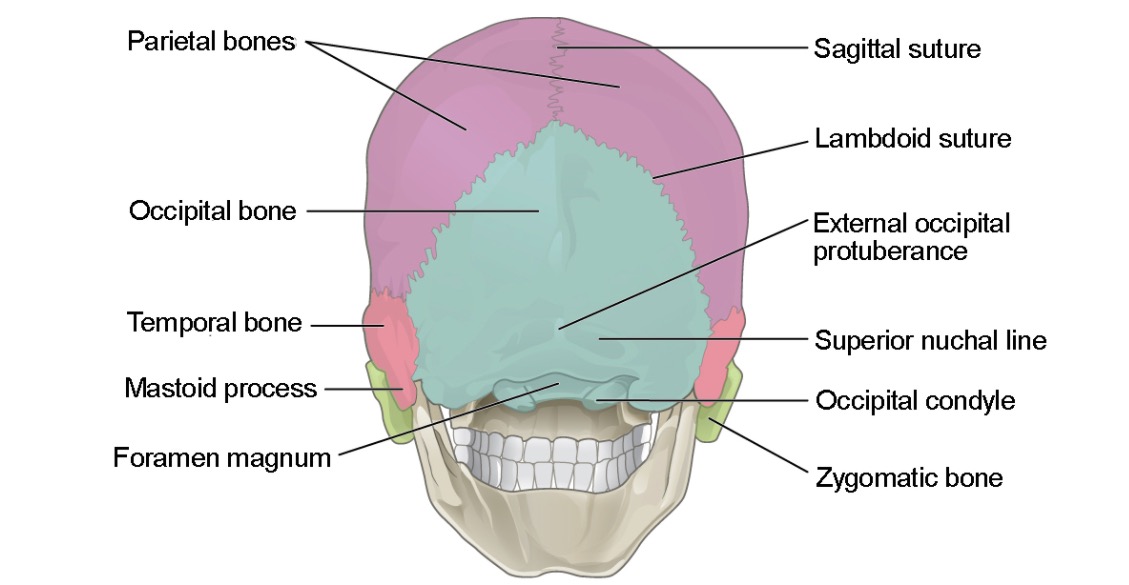Playlist
Show Playlist
Hide Playlist
Frontal Bone
-
Slides Anatomy Frontal Bone.pdf
-
Download Lecture Overview
00:02 Now let's take a closer look at the bones of the skull. 00:05 Starting with the frontal bone. 00:09 Here we have a little area that's going to participate in the orbit. 00:13 So this is the orbital part of the frontal bone. 00:18 Similarly, this portion in the midline is going to participate in the nasal formation. 00:24 So we call this the nasal part of the frontal bone. 00:29 The flatter parts are called the squamous part. 00:32 Squamous means scale like so whenever you see that term, it usually means something flat. 00:38 We also have the portion that's going to interact with the zygomatic bone. 00:42 So that's the zygomatic process. 00:46 There are some big bumps on the squamous portion that we call the frontal tubers. 00:53 And then where we have these arches above the orbit. 00:56 We call them the superciliary arches. 01:00 There's a little spot or depression in between the two. 01:03 That is a landmark called the glabella. 01:07 And then we call the edge of the upper portion of the orbit. 01:11 The supra-orbital margin. 01:15 In this area, the supra-orbital margin there are a couple landmarks that are pretty important because of what passes through them. 01:22 So we have a supraorbital foramen. 01:25 Through which the supraorbital nerves and vessels pass. 01:29 There's also a frontal notch through which the supratrochlear artery passes. 01:34 And trochlear is a term that has to do with eye movements and eye muscles that we'll talk about in later sections. 01:43 For the squamous part. 01:45 We have borders with the zygomatic bone. 01:47 Borders with the parietal bone. 01:50 Borders with the sphenoid bone. 01:53 We also have borders with the nasal part. 01:57 And there are actually a lot of bones in this area that are pretty small. 02:01 For example, the nasal bone lacrimal bones, part of the maxilla. 02:05 And part of this deep bone called the ethmoid bone. 02:09 That has a plate that runs perpendicularly. 02:13 The frontal bone has a little gap on the medial aspect called the ethmoidal notch. 02:20 And that's going to be the location of the ethmoid bone. 02:25 We also have little depressions if we were to look upward from below, on the lateral aspects of the orbital area. 02:34 And those are fossa or depressions for the lacrimal glands. 02:38 Lacrimal means tears and these are the glands that are going to produce tear fluid. 02:45 We also have a shallow depression here called the trochlear fovea. 02:49 Which is a spot for the trochlea or a little pulley. 02:53 That interacts with one of the muscles of extra ocular movement. 02:59 Here we see that little trochlea or pulley and it's a fibrocartilaginous sling through which the muscle called the superior oblique passes through.
About the Lecture
The lecture Frontal Bone by Darren Salmi, MD, MS is from the course Skull.
Included Quiz Questions
The trochlear fovea is contained within which part of the frontal bone?
- Orbital
- Nasal
- Superciliary
- Squamous
- Supraorbital
Which bones form borders with the squamous part of the frontal bone? Select all that apply.
- Zygomatic
- Parietal
- Sphenoid
- Maxilla
- Mandible
Customer reviews
5,0 of 5 stars
| 5 Stars |
|
5 |
| 4 Stars |
|
0 |
| 3 Stars |
|
0 |
| 2 Stars |
|
0 |
| 1 Star |
|
0 |




